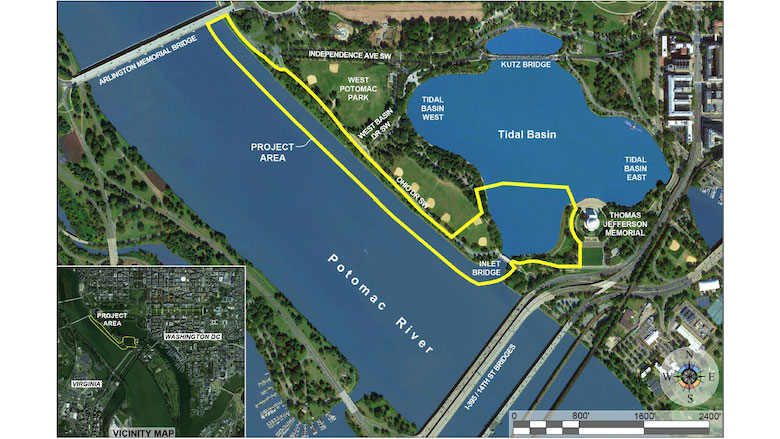The National Park Service is moving ahead with plans to repair, rebuild and raise aging and crumbling seawalls in Washington, D.C., including landmark areas around the Tidal Basin—the site of the Jefferson Memorial and Japanese cherry trees, whose springtime blossoms annually draw throngs of visitors.
Under a $5.7-million task order from the park service, a team of HDR and Moffatt & Nichol is working on design and other early stage work for an initial segment of the project.
The task order is part of an indefinite delivery/indefinite quantity contract awarded to the joint venture in April.
In all, plans call for rehabilitating about 5.4 miles of seawalls along the Potomac River and the Tidal Basin.
 Map Courtesy National Park Service
Map Courtesy National Park Service
The first project under the HDR-Moffatt & Nichol ID/IQ contract is for rehabilitating and reconstructing 1.6 miles of seawalls around the Tidal Basin and along the edge of nearby West Potomac Park, HDR Program Manager Kent Brogger told ENR via email.
More specifically, the task order includes preliminary design, schematic design and developing a design-build request for proposals for that 1.6-mile section.
According to a park service presentation for a July 19 public-scoping meeting—part of the environmental assessment and historic preservation process for the project—the targeted contract award and construction period extends from about mid-2023 to 2027. The Tidal Basin section of the construction is to be completed in early 2025 and construction on the West Potomac Park section is to extend beyond into 2026.
Daily Overtopping
Parts of the seawall date from the late 1800s, according to the HDR-led joint venture. Some sections were replaced in the 1930s and 1940s.
The joint venture says parts of the walls have since settled by as much as 5 ft and are overtopped daily.
The project’s aim, among other goals, is to restore the seawalls’ “functional height” and to stabilize or eliminate the settlement, among other goals, the park service presentation says.
Plans call for raising the seawalls by several feet. The park service also aims to salvage and reuse stone from the existing historic walls to build the higher new ones. Other tasks include replacing the sidewalk atop the seawall along the Tidal Basin; rehabilitating the landscape; and repairing infrastructure, which may include grading and improvements to pedestrian and multiuse paths.
Dedicated Funding Stream
The project’s funding comes from the 2020 Great American Outdoors Act, which authorizes up to $9.5 billion over five years for projects that would reduce the backlog of infrastructure maintenance needs in national parks and on other federal lands.
The funds come from revenue from royalties the federal government receives from oil, gas, coal and renewable-energy production on onshore and offshore federal lands.
Under the statute, 70% of the total funding, or up to $1.3 billion per year, goes to the park service.



Post a comment to this article
Report Abusive Comment